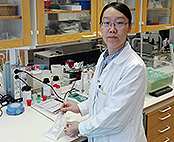A new potato for everyone who likes slow carbohydrates

A novel potato that contains modified starch has been developed by researchers in plant breeding, and now, a study carried out by food scientists shows that the modification has resulted in a healthier starch.
Considering that we eat a lot of potato in Scandinavia, potato starch makes up a large part of the energy in many people’s daily diet. If a new potato with a more resistant starch would be commercially available in the future, it might have a positive impact on public health. Resistant starch is a dietary fiber with benefits for our bodies. As such, it lowers the glucose levels and the insulin responses, increases fecal output and reduces the fecal transit time. It decreases the calorie content in foods which is related to weight loss, and it promotes the growth of beneficial gut bacteria.
Such a new potato was successfully developed by plant researchers in the research programme Mistra Biotech, at the Swedish University of Agricultural Sciences, by down-regulating two starch branching enzymes. Potato starch usually consists of 25 percent amylose (linear molecules) and 75 percent amylopectin (highly branched molecules). The objective with this modification was to produce a potato with high amylose content.
In a recent study, PhD student Xue Zhao and her supervisors Roger Andersson and Mariette Andersson show that a high content of amylose gives a high content of resistant starch in this cooked potato. But they also found something else.
– The down regulation of the enzymes had an effect on amylopectin structure where the outer chain-length of amylopectin was much longer than in the unmodified potato cultivar, Xue Zhao explains.
This unique amylopectin has properties that are similar to amylose. After cooking, the modified amylopectin recrystallizes, and after that it is not split as easily as the ordinary potato starch, which means it is more resistant and takes longer time to digest.
– An additional analysis revealed that one extra day of cold storage gives a further increase of resistant starch content, since amylopectin needs some time to get recrystallized, says Xue Zhao.
The study showed that the resistant starch content was influenced both by the amylose/amylopectin ratio and by the amylopectin structure. These are important findings in order to design functional starch and healthier food.
The potato was developed using genetic modification. At the moment the researchers are working on a new similar “high amylose” potato using the genome editing technique Crispr/Cas9.
Contacts
Roger Andersson, Professor
Department of Molecular Sciences, SLU
+46 (0)18-671597, roger.andersson@slu.se
Xue Zhao, PhD student
Department of Molecular Sciences, SLU
+46(0)70-744 68 73 or +46(0)18-67 19 82
xue.zhao@slu.se
Mariette Andersson, Researcher
Department of Plant Breeding, SLU
+46(0)40-41 55 41, mariette.andersson@slu.se
Additional information
Read more about Tc4F and Mistra Biotech
Previous press releases about potato with altered starch qualities
- Compostable plastics made from potato and wheat
- Specialpotatis för stärkelseindustrin blir Sveriges första ”CRISPR-Cas9-gröda”
The article
Zhao, X., Andersson, M. & Andersson, R. 2018. Resistant starch and other dietary fiber components in tubers from a high-amylose potato. Food Chemistry DOI: https://doi.org/10.1016/j.foodchem.2018.01.028
Press image
(May be published freely in articles about this press release. Photographer must be entered.)
Xue Zhao. The plastic bag contains potato starch made from the new potato. Photo: Gleb Dotsenko
